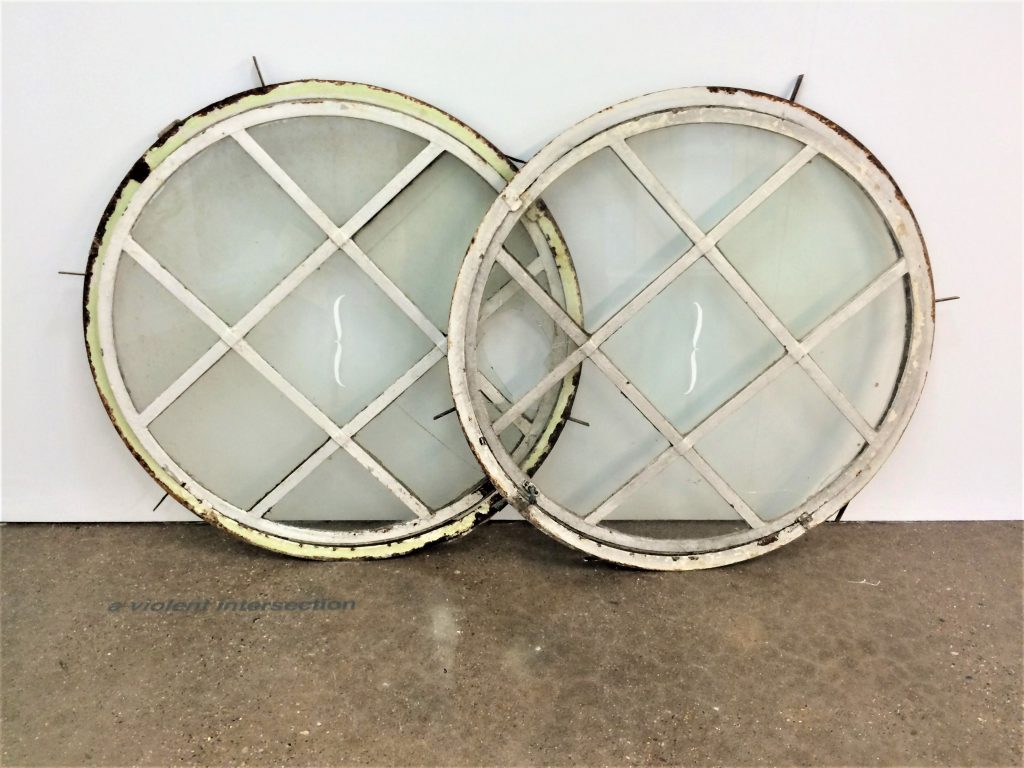
180cm x 110cm x 30cm
Reclaimed windows, enamel sign writing
In the text ‘Counterfactual Thinking – Counterfactual Writing’, edited by Dorothee Birke, Michael Butter and Tilmann Koppe, the term ‘counterfactual’ is referred to as the ability to ‘construct alternatives to what really happened’ in the form of ‘mental juxtapositions’ achieved through writing, in which, they highlight as not uncommon in our day to day lives, as we ‘sharpen’ our awareness to think through how best to plan and carry out projects [1].
In the essay ‘What Might Have Been Is Not What Is’, Robyn Warhol pays reference to Martin Hilpert’s contextualisation of the term ‘causal inference effect’, to define how a psychologist draws conclusions through acts of ‘reasoning’, based upon causal connections established between the conditions of an occurrence and its effects. Distinguishing how the psychologist ‘yield[s]…the power of counterfactual scenarios’ to gain ‘insights into the causes of actual outcomes’, Warhol states how the ‘causal inference effect’ leads the psychologist to create a ‘conceptual blend’ of ‘conflicting situations’, which, in terms of writing, she defines as a ‘grammatical phenomena’ [2].
Referring to the term ‘counterfictionality’ as a method, in which, an author must cross the ‘threshold of narratability’ to explore the ‘unnarratable’ or ‘narrative refusals’, Warhol states how the author can ‘explicitly’ draw attention to a ‘present absence’, by invoking ‘narrative elisions, suppressions, repressions, silences, gaps, omissions, or lacunae’, to make room for the reader to ‘reflect through fictional worlds about our actual world’ [3].
Referring to a ‘shadow world’ as a method an author can adopt to counterbalance ‘grim’ or ‘seedier’ situations within a story world, through the realisation of possibilities or ‘desires’, Warhol states how a ‘shadow world’ can also be formed unconsciously, through drives unknown to the author. Defining an unconsciously created ‘shadow world’ as a ‘split’ scenario, which can playout in ‘parallel’ to the intended story world, in both instances, whether the ‘shadow world’ is created knowingly or unknowingly, Warhol anthropomorphizes the alternative and refers to it as a narrative that is ‘not quite not-there’, but ‘lurk[s]’ between the gaps of negation, ‘somewhere in the space between the…idyllic story world implied…and the imagined world represented’ [4].
Exploring the depths of Warhol’s ‘counterfictional’ study, she recounts how Charles Dickens was considered aware of his audience wishing for a ‘happier story world’, but unwilling to meet such demands and to maintain his ‘drive’ and ‘motivation’ to write his stories, he purposely constructed ‘blanks’ within his narrative prose, to ‘bring into being that which is not’ [5].
Not because I was squeezed in at an acute angle of the tablecloth, with the table in my chest, and the Pumblechookian elbow in my eye, nor because I was not allowed to speak (I didn’t want to speak), nor because I was regaled with the scaly tips of the drumsticks of the fowls, and with those obscure corners of pork of which the pig, when living, had had the least reason to be vain.
Dickens, C. ‘Great Expectations’, in D. Birke, M. Butter and T. Koppe (Eds), ‘Counterfactual Thinking -Counterfactual Writing’. De Gruyter: Berlin/Boston, 2011, p229
Defining how Dickens implanted ‘conflict and complications’ within his story worlds to encourage his readers to reflect upon their own life experiences and imagination, to fill the gaps in his narrative in a way that pleased them, Warhol delineates how Dickens created ‘narrative construction[s] of interiority’ to interchange between internal monologues and a detached, third-person narrative, which caused the reader to undergo the experience of falling-in and out of his characters worlds, used as a reflective device to influence the reader to draw their own conclusions from Dicken’s ‘performative statements’ and ‘utterances’, which were ‘neither true nor false’, but where there to harbour a ‘promise’ or a ‘threat’. [7]
[1] Dorothee Birke, Michael Butter, Tilmann Koppe (Eds). ‘Counterfactual Thinking – Counterfactual Writing’. De Gruyter: Berlin/Boston 2011, p.1-7
Birke, Butter and Koppe refer to the different conceptions of the term ‘counterfactual’ across psychology, philosophy, historiography, political sciences, linguistics, physics and literary studies to frame an ‘interdisciplinary exchange’ and a wider dialogue between each discipline.
[2] IBID. ,Robyn Warhol. ‘What Might Have Been Is Not What Is’. p227-239
[3] IBID.
[4] IBID.
[5] IBID.
[6] IBID.
[7] IBID.